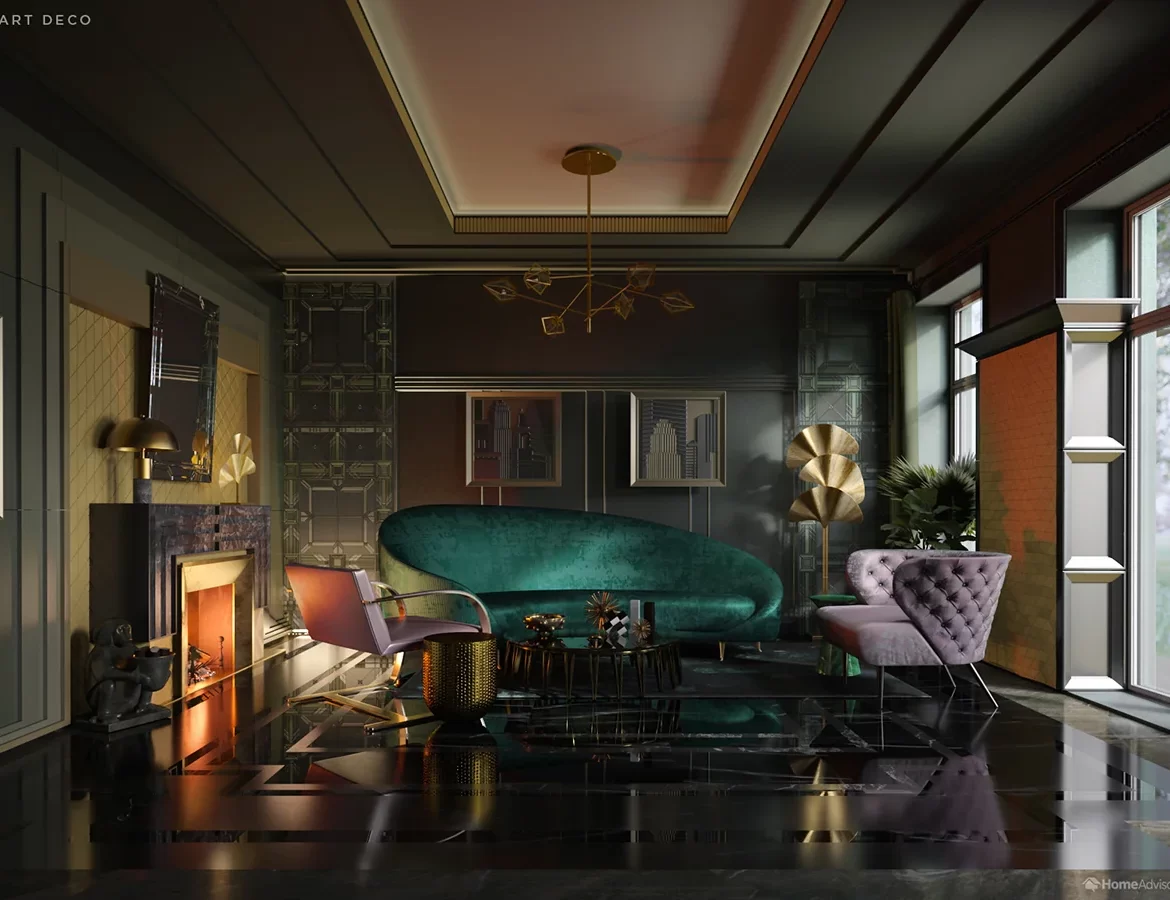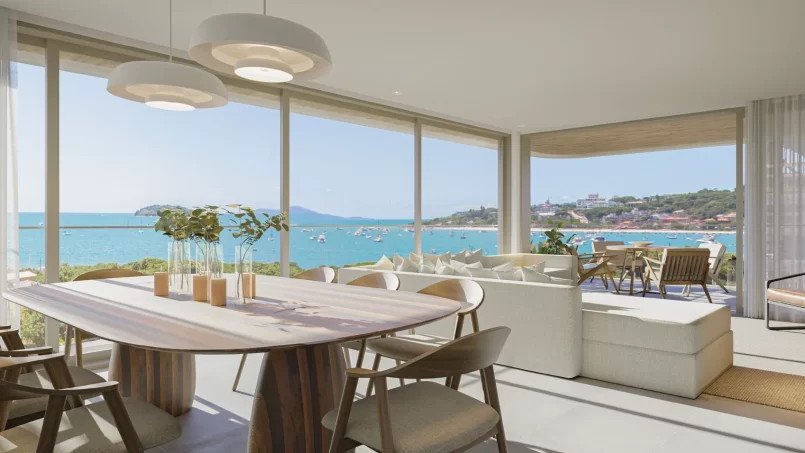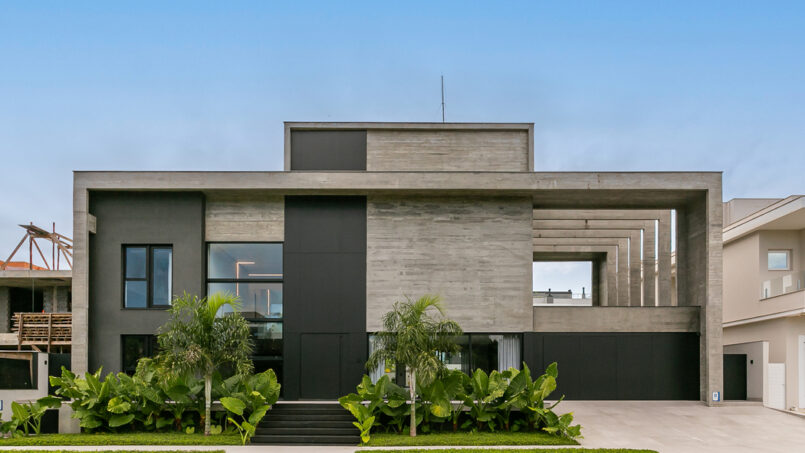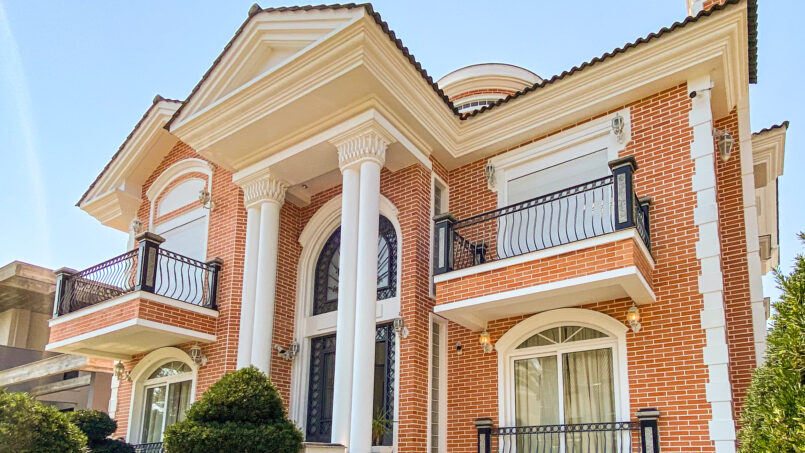Interior Design: Images show evolution over 500 years
Interior design, the art of shaping internal space to make it functional, aesthetic and comfortable, has deep roots in the history of civilization. In other words, since the first civilizations that sought shelter and protection, the way we decorate and organize our internal environments reflects our cultures, values and technological advances.
So, join us on a journey through time, exploring the evolution of interior design over the last 500 years. In this way, we will see how trends have changed, from the opulence of the Renaissance to contemporary minimalism. As well, we will discover the cultural, social and economic forces that have shaped the way we live indoors. Based on this principle, the designers of the HomeAdvisor created illustrations to show how decoration and design have evolved over the last more than 500 years. Check out.
Renaissance (1400 – 1600)

Art and culture were reborn as the French Renaissance spread across Europe. Architects found a new enthusiasm for ornate decorations and fine details. In this way, inspired by a new sense of humanism and freedom. Arab and Asian influences revitalized decorative art styles. As well, careful attention to symmetry and geometry has brought a new sense of harmony to European interiors.
In our image of the Renaissance living room, the closet was designed in the shape of a small palace, common at the time. Therefore, its columns and balconies echo the shape of the building, evoking harmony. The Turkish rug is inspired by one seen in a painting by Hans Holbein the Younger, a German painter who lived in Renaissance-era London. As well, rugs like this were first woven in western Turkey in the 14th century and became very popular in Renaissance Europe.
Economic influences: The Renaissance coincided with a period of economic prosperity in Italy. The growth of commerce and patronage allowed the wealthy to commission luxurious works of art and furniture for their houses.
Social context: Renaissance society was hierarchical and the home was seen as an extension of social status. The opulent interiors served to impress visitors and demonstrate the owner's wealth and power.
Rococo (1700)

In the late Baroque period, a subset of the design style briefly stole the spotlight. The Rococo style (from the French rocaille, meaning shell ornamentation) was famous for just three decades during the reign of Louis XV. Therefore, it is lighter, more whimsical and freer than the baroque. For some, it suited the intimacy of the family home better than the grand style of the church that preceded it.
The shell and flower motifs in our Rococo living room are typical of the interior design style's more playful influence on home decor. As well, the cabriole legs and roller feet of the furniture delicately balance the high spirits and elegance. Social gatherings at home were becoming more common in the early 18th century. In this way, the Rococo style allowed owners to demonstrate their wealth and taste without appearing ostentatious or rigid.
Economic influences: The Baroque period coincided with the Catholic Counter-Reformation in Europe. The Catholic Church became an important patron of the arts, commissioning works of art and design for grand churches and cathedrals.
Social context: Baroque society was marked by ostentation and the display of wealth. The baroque interiors served to impress visitors and demonstrate the owner's spiritual devotion.
Neoclassical (1780 – 1880)

The late Georgian era brought a new era of architecture that responded to the Baroque and Rococo periods. The rediscovery of Pompeii contributed to new understandings of Roman and Greek architecture. In other words, it inspired a movement towards more 'sophisticated', refined and timeless living room ideas, free from the pomp and novelty of the baroque trend.
Notice the straight lines and the logical, almost mathematical layout of our neoclassical living room. These design principles were spread across Europe by artists studying at the French Academy in Rome. So notice the column-like shape of the fireplace, lamps, and panels. The colors were muted and not dramatic. Furthermore, a simple palette emphasized the stoic and superior sense of form that neoclassicism embodied.
Economic influences: Neoclassicism coincided with the Enlightenment, a period of scientific and intellectual progress. Interest in classical antiquity grew, and archaeological discoveries inspired interior designers.
Social context: Neoclassical society emphasized reason and order. Neoclassical interiors reflected these values, creating functional and elegant spaces.
Arts and Crafts (1860 – 1910)

The Arts and Crafts movement began in England as a reaction against the mechanization of creativity and the economic injustices of the industrial era. As such, it wasn't so much a style as an approach, returning responsibility for design and craftsmanship to the hands of skilled workers. However, Arts and Crafts interiors shared an aesthetic of simplicity, material quality, and a connection to nature.
The ideas and appearance of the Arts and Crafts movement spread into American living rooms via the influence of touring architect-designers, magazines, and society lectures. Gustav Stickley was America's leading Arts and Crafts designer. This way, you can see its influence in the robust, functional, and exposed joinery of the furniture in the image, which highlights the exposed joints. As well, the emphasis on wood, brass and artisanal flair gives Arts and Crafts interiors a dark, earthy and textured palette.
Economic Influences: The mechanization of production and the proliferation of industrialized products generated discontent among artists and artisans, who saw quality and individuality being sacrificed in the name of efficiency and low cost. Arts & Crafts sought to rescue the value of manual work and artisanal production, valuing the quality of materials and the beauty of the creative process.
Social context: Arts & Crafts was inspired by the Middle Ages and the Renaissance, eras considered to be periods of great craftsmanship and appreciation of natural beauty. This nostalgia for the past was a reaction to the mechanization and standardization of the Industrial Revolution, which many saw as a loss of tradition and cultural identity.
Art Nouveau (1890 – 1920)

Art Nouveau was a 'new art' for a new century. Interior designers combined craftsmanship with new industrial techniques, which often made the process expensive. Furniture and accessories were whimsical and modern, displaying the influence of Japanese art, which European artists were seeing for the first time in the late 19th century.
The vases and lamps in our Art Nouveau living room are inspired by Louis Comfort Tiffany, the celebrated artist and Tiffany's first Design Director. As well, its blown glass forms were a tribute to the natural world, and its lush, iridescent, undulating colors are typical of Art Nouveau.
Economic influences: Art Nouveau coincided with a period of economic prosperity in Europe and the United States. The expanding middle class sought to differentiate itself from the elite through the decoration of its houses.
Social context: Art Nouveau society was marked by individualism and the search for beauty. Art Nouveau interiors reflected these values, creating unique and personalized spaces.
Art Deco (1920 – 1960)

If Bauhaus and Modernism were the utilization of 20th century advances, Art Deco was a glamorous celebration. That is, interior designers were inspired by the geometry and movement of the machine age, the materials and symbols of ancient cultures, and rebirth in nature. That way, they weren't afraid to use it all together.
Designers created a sense of opulence using a wide range of materials, including lacquered wood, colored glass, stainless steel, aluminum, jewels and leather. Additionally, the use of bold colors and striking contrasts evoked power and confidence.
Straight, strong lines echo in the fireplace and in the mirror cutouts, reminiscent of the skyscrapers in the engravings on the wall. As well, lines boldly contrast the shell-shaped sofa, the fluid chairs and the pointed ornaments and the plant.
Economic influences: Art Deco coincided with the Jazz Age and the economic boom of the 1920s. The upper class sought to flaunt their wealth by decorating their homes. houses.
Social context: Art Deco society was optimistic and hedonistic. Art Deco interiors reflected this atmosphere, creating vibrant, inviting spaces to socialize and enjoy.
Modernism (1880 – 1940)

Like the Arts and Crafts movement, Modernism is less a style than a philosophy. “A house is a machine for living in,” said Swiss architect and designer Le Corbusier, the pioneer of Modernism. The modernist living room used the latest materials and technologies. Thus, designed to be comfortable, functional and accessible. Beauty was a bonus, although elegant design solutions were highly valued.
These 'limits' proved inspiring to the first generation of professional 'interior designers'. The table you see above is inspired by a famous design by Japanese-American designer Isamu Noguchi. It just consists of a glass plate, two identical wooden supports, and a pivot rod to hold them together. Additionally, the original Anglepoise lamp was invented by an engineer inspired by his work on vehicle suspension. In other words, demonstrating the close connection between modernist interiors and 20th century industry.
Economic influences: Modernism coincided with the post-World War II economic boom. Mass production of furniture and building materials made modernist decor accessible to the middle class.
Social context: Modernist society was marked by practicality and the appreciation of free time. Modernist interiors reflected these values, creating functional and comfortable spaces for relaxing and socializing.
Bauhaus (1919 – 1934)

The Bauhaus (rhymes with 'cow-house') was an extremely influential German school of art and architecture. It existed for just 14 years until the Nazi government closed it in 1933. Bauhaus design was a radical subset of Modernism, with a greater emphasis on the human spirit and the craftsman. Just like Modernism, form followed function. Bauhaus interiors were true to their materials, meaning they didn't hide the underlying structure of a piece of furniture to make it look beautiful.
Our Bauhaus rug is inspired by the work of Anni Albers, a graduate and teacher of the Bauhaus school. Albers experimented with form and color to produce textiles that were equal parts art and craft. The lamp is modeled after the MT8 or 'Bauhaus Lamp'. Its circular, cylindrical and spherical parts create geometric unity and can be constructed with minimal time and materials. This type of opaque lampshade had previously only been seen in industrial environments.
Economic Influences: The Industrial Revolution led to the mass production of consumer goods, thus opening up new possibilities for the design of functional objects accessible to the middle class. Therefore, the Bauhaus embraced this new reality and sought to integrate art and design into industrial production.
Social context: The Bauhaus was an intellectually vibrant movement, open to new social ideas. Its members advocated gender equality, social justice and the internationalization of culture. Therefore, the Bauhaus was inserted in the context of the artistic avant-garde of the early 20th century, which sought to break with traditional forms and explore new expressive languages. In other words, the movement was inspired by different styles, such as cubism, constructivism and expressionism.
Mid-Century Modern (1930s – today)

The Mid-Century Modern movement emerged as a softer, more suburban interpretation of Modernism, integrating natural elements. Interior designers introduced rustic elements and freer use of color inspired by Scandinavian and Brazilian furniture trends. Materials like rattan, bamboo, and wicker felt both natural and modern when brought into the living room in the form of chairs, mirrors, and ornaments.
Accent lighting remains a simple way to add charm to a well-used family living room. The dome and floor lamp in our image borrow formal elements from Modernism and Bauhaus, but have the playful look of repurposed outdoor tools. The bright mustard of the armchair and vases exemplifies the common Mid-Century Modern technique of combining muted neutrals with a saturated signature color.
Economic influences: Modernism coincided with the post-World War II economic boom. In other words, the mass production of furniture and building materials made modernist decoration accessible to the middle class.
Social context: Modernist society was marked by practicality and the appreciation of free time. Therefore, modernist interiors reflected these values, creating functional and comfortable spaces for relaxing and socializing.
Post-Modern (1978 – today)

Postmodern design can trace its artistic influences from surrealist Marcel Duchamp, through Pop Art buffoon Andy Warhol, to the ambiguous tastes of Jeff Koons. In this way, it all came together in the 1980s, when designers broke free from the constraints of Modernism and approached interiors with a sense of humor and the bold confidence we associate with the decade.
In a postmodern living room, every piece is a conversation piece – because each one has a double meaning or a visual joke to unravel. The arches in our image question classical ideals of form, both flattening and unflattening a traditionally austere form with an optical illusion conjured by its irreverent color palette. As well, the meaning of the rug is simpler. In other words, it adds a rock n' roll touch with its vinyl record form – a tongue-in-cheek celebration of late 20th century materialism in the style of Warhol.
Economic influences: Postmodernism coincided with globalization and the rise of consumerism. In this way, the variety of products and styles available on the market inspired designers to create unique and personalized interiors.
Social context: Postmodern society is marked by individuality and the appreciation of personal expression. Therefore, postmodernist interiors reflect this diversity, creating spaces that celebrate creativity and originality.
Contemporary (1980 – today)

An era full of clutter demands an uncluttered living room. Today's contemporary style borrows the clean lines of Modernism and the airy, outdoorsy feel of the Mid-Century Modern home. Interior designers in the 2010s love to reference the Bauhaus, removing surfaces to show the materials in use. However, today's cutting-edge building materials and fabrics can live happily alongside repurposed industrial features from bygone eras.
The smooth, clear floor and uncluttered walls of our contemporary living room create a typical feeling of space and light. Abstract art on the walls keeps the area from feeling empty and highlights the subtle style of the minimalist space. Also note the use of lines to direct your eye around, like the horizontal central light, which is extraordinary and very simple – and seems to enlarge and elevate the room.
Economic Influences: The intensification of international trade and global interconnection have influenced interior design through the spread of styles. As well as materials and technologies from different cultures.
Social context: Currently, the appreciation of individuality and self-expression is reflected in interior design. Through the search for unique and personalized spaces that represent the personality and lifestyle of the inhabitants. In this way, the growing cultural diversity in contemporary societies has influenced interior design through the incorporation of elements from different cultures and ethnic styles. Furthermore, functionality remains an important principle in contemporary interior design, seeking to optimize the use of space and meet the needs of inhabitants. As well, technology integration such as home automation, entertainment systems and connectivity solutions is a growing trend in contemporary interior design.
The Evolution of Interior Design
Over the past 500 years, interior design has undergone remarkable transformations, reflecting the cultural, technological and aesthetic changes of each era. Ultimately, from the ornate splendor of the Renaissance to the functional elegance of Modernism, each period brought new ideas and influences that shaped the spaces where we live and interact.
In each era, interior design has not only met practical needs but also expressed the values and aspirations of society. Today, contemporary design continues to evolve, incorporating lessons from the past while looking to the future. In an increasingly connected and globalized world, interior designers have access to a rich tapestry of styles and materials, allowing them to create environments that are at once functional, beautiful and meaningful.




